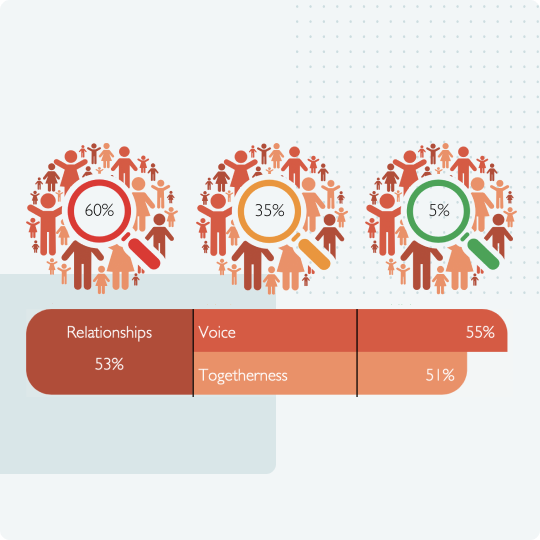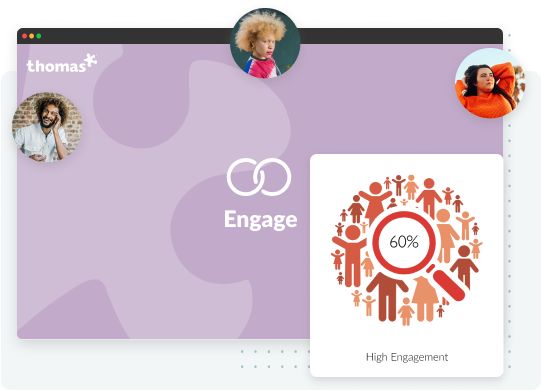Employee Engagement Survey Assessments
Establish levels of engagement within your organisation
- Understand the trends and patterns of engagement
- Identify the best areas to direct engagement initiatives
- Explore the different management styles present in your organisation
- Uncover issues that may be impacting productivity and well-being
- Compare engagement levels to gain a holistic view
- Understand your organisation's relative strengths and opportunity areas


Check out the latest reviews from our most delighted customers
How the employee engagement survey works
Making sure your staff and managers can rapidly pinpoint the issues that contribute to under performance and keep performers focused.
Boost productivity
Understanding engagement trends in your organisation allows you to focus your efforts in the right places; increasing engagement will directly boost the productivity levels across your organisation.
Management styles
The Thomas employee engagement assessment reveals the prevailing management styles in your organisation, are they participative, autocratic, laissez-faire or informal.
Enhance well-being
Understand the primary motivators of teams and groups across your business, using the insight to build targeted well-being programmes.

Assessment Information
- Assessment type: Engagement Survey
- Format: A blend of rating scales and free-text response options
- Time to complete: 5-10 minutes
- Training required: No training required

It was brilliant to be able to understand why and where we were making mistakes.

Background & Theory
Thomas Engage (originally the Work Engagement Questionnaire) was developed by Mark Slaski at the University of Hertfordshire in 2009.
Slaski grounded his research and development in the psycho-social theory of workplace engagement – that engagement is a positive experience resulting from the relationships you have, the role you do and the rewards you get in the workplace.
Statistical factor analyses were conducted to identify the underlying seven areas of engagement being measured by the questionnaire; Voice, Togetherness, Challenge, Freedom, Clarity, Recognition and Growth.

Format
The Thomas Engage questionnaire is formed of 28 statements. An individual must indicate their frequency of experience on a 1-7 Likert scale (1 being 'never' and 7 being 'always'). The 28 questions are followed by two pre-set questions with free-text responses. Individuals will be asked to confirm several demographic factors at the end of the questionnaire.

Reliability & Validity
Thomas Engage has an impressive internal consistency (Cronbach's alpha = .96) and very good construct validity. Structural equation modelling (SEM) suggested high construct validity of the final 7-factor model model, with each outcome variable able to explain a large amount of the variance in engagement.
Frequently Asked Questions
<h6 id>What is an employee engagement survey?</h6 id>
An employee engagement survey measures and assesses how motivated and importantly, engaged your employees are to perform their best at work. A well defined and created employee engagement survey will give insights into employees thoughts, attitudes and overall wellbeing.
Thanks to remote working, it is more important than ever to check in with your employees and understand how engaged they are in their work.
The main purpose of an employee engagement survey is to understand what is driving engagement in the organisation and what are the things that could potentially stop it as well. Being able to have an understanding of employee satisfaction and engagement gives insights into the processes that are working, and the ones which are not.
Good employee engagement surveys help uncover strengths and weaknesses of how the organisation runs, or how the work is carried out, and in return, this gives the feedback to help improve employee engagement in the long run.
In short, an employee engagement survey allows managers and senior officials within an organisation to monitor engagement levels and understand if action needs to be taken wherever necessary.
<h6 id>How does an employee engagement survey work?</h6 id>
An employee engagement survey works by asking employees to fill out a survey. This should be designed to be individually tailored for each business and carefully thought out to reflect current work and any external factors that may influence responses (e.g. a global pandemic).
Key to a good employee engagement survey is to keep things simple. One of the last things you want to do is to create a survey that appears daunting at first glance. Most people in your business are going to be busy and if there are lots of questions or they appear to be irrelevant to the organisation, this will lead to fewer survey responses or worse, the process not being taken seriously.
A typical employee engagement survey should be short, focused and take 15 minutes or less to complete. The questions should be a blend of open-ended and closed-ended questions and provide you with a mixture of qualitative and quantitative data that can be used to assess the current engagement situation of your staff members.
The Thomas employee engagement survey is formed of 28 statements. An individual must indicate their frequency of experience on a 1-7 Likert scale (1 being 'never' and 7 being 'always'). The 28 questions are followed by two pre-set questions with free-text responses. Individuals will be asked to confirm several demographic factors at the end of the questionnaire.
<h6 id>What kind of questions are included in employee engagements surveys?</h6 id>
If the idiom “there are many ways to skin a cat” exists, then “there are many questions you can ask your employees” should also be one. Admittedly it’s less catchy, but employee engagement surveys do require some careful consideration. You can mix standard style questions typically found on surveys and bespoke questions which you will have spent time putting together.
Importantly you want to gather a mixture of qualitative and quantitative data from the responses to give you and your organisation a better understanding of the level of engagement within your organisation.
Typical questions that you can include in an employee engagement survey include:
- Are you satisfied with the way your company has managed both its business and people during this time?
- Do you feel inspired to do your best work thanks to your team?
- Do you feel your team helps you to complete your work?
- Does your organisation maintain adequate communication with all of its employees?
- Do you feel that you can talk to someone in your organisation if you encounter difficulties?
<h6 id>Why use an employee engagement survey in the workplace?</h6 id>
Being able to measure employee engagement is the most important aspect of carrying out employee engagement surveys. Knowing how your team or an individual is feeling is critical to overall workplace culture and success. But there are other advantages of using a survey with your team.
Employee engagement surveys have become crucial to give employees a platform to provide open feedback. It is one of the simplest and most effective ways to establish two-way communication between the employee and the organisation and also provide a channel to give feedback to senior management.
One of the main consequences of conducting the survey should be that you then get to develop employee engagement. The information that you get from the survey should allow you to identify the strengths and weaknesses for improving engagement in your organisation. This can be turned into an engagement plan and let you focus on areas of your business that need the most improvement. Once you’ve identified the changes, you can set deadlines and put adequate resources in place to improve employee engagement.
<h6 id>How can an employee engagement survey help with staff retention and development?</h6 id>
When employees are not engaged at work, they are more likely to leave. Discovering the issues that could be causing lack of engagement will reverse the trend or tendency for staff turnover. Unfortunately engagement is not easily resolved by throwing money at the problem (pay increases), it is a cultural change that needs to occur.
Staff retention is essential for business success, especially if the staff you are hiring are highly qualified and have all the capabilities to let your business succeed. But if there is a cultural problem that needs to be addressed and fixed, keeping hold of your best staff is difficult. A report from Deloitte in 2018 indicated that the average cost of recruiting a new staff member is $7000 (£4000). Add to that the costs of training and time spent developing, your business will be grossly impacted.
Some studies indicate that highly engaged staff members are three times more likely to stay in their position, and five times more likely to speak positively about their place of work. This creates a stronger brand ambassadorship and staff working to make their customers feel fulfilled increasing sales and profitability.
<h6 id>How can Thomas help with employee engagement?</h6 id>
Our employee engagement surveys help organisations identify and build on the strengths and talents of their workforce.
When people are engaged, they are more productive, perform better and deliver more in terms of results. This in turn reduces staff turnover, improving productivity and efficiency, ultimately leading to an increase in profits.
Thomas Engage establishes the levels of engagement within your organisation and identifies strategies and initiatives to enhance employee wellbeing, motivation and productivity.


